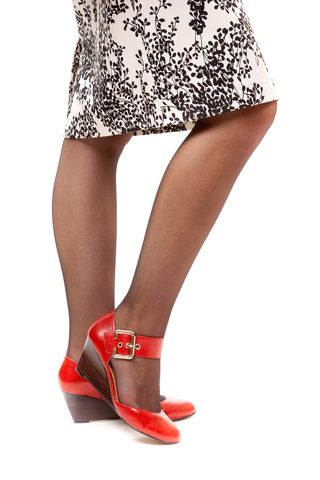Compression stockings can be a friend or a foe, depending on whether they are used properly.
Support hosiery is definitely not an example of one size fits all. Quite to the contrary, the opposite is the case.
Proper sizing and fitting are key to getting the maximum benefit from your compression hosiery.
If you are unsure about this please also read our post titled
The Importance of Correct Measurements and Sizing
It may surprise you but studies in the USA and other countries have discovered over and over again that the incorrect use of compression stockings, even in hospitals and other patient care facilities, is a fairly widespread issue.
For example, an AJN (American Journal of Nursing) study dating back to 2008 showed that compression stockings were used incorrectly on nearly 29% of patients. In addition, 26% of the studied patients wore the wrong size. At least 20% of the participating patients did not understand the stockings’ purpose. Ref.: AJN.2008;108(9):40-50, Winslow E H, Brosz D L..
Incorrect Use of Compression Stockings by the Patient can be Due to any of the Following Reasons:
Wearing the wrong circumference size of stockings due to an incorrect measuring process of ones legs or by using the wrong size entirely. The sizing of compression stockings can be particularly difficult with overweight patients that have very large legs and may require custom sized stockings.
Choosing the wrong compression level by not observing the recommendations of a physician or medical specialist.
Opting for compression legwear that is too hard to put on or take off (this often discourages older or physically challenged patients from wearing on a daily basis).
Choosing the wrong type of graduated compression stocking (knee-high, thigh-high or pantyhose style, footless, footed, tights, leggings or compression sleeves) depending on the condition being treated.
Wearing compression stockings of the wrong length (e.g. folding them over if too long, allowing them to bunch up behind the knees or at the ankles or crowding of the toes if toe box is sized inadequately).
Incorrect Use of Compression Stockings by a Nurse or Caregiver can be Due to Any of the Following Reasons (based on Findings from Studies):
Lack of adequate staff training to assess and measure the patient’s legs correctly to ensure proper sizing of the compression garments. This can be particularly challenging with overweight patients who frequently have very large legs. They may exceed the dimensions of standard sizing charts of compression stockings manufacturers and may therefore require custom sized compression stockings.
Insufficient training of medical staff and inadequate best practice recommendations on the topic of wearing compression stockings.
Compression stockings, especially thigh length, can be difficult to put on if the patient is bed ridden or unable to assist in any way. This can lead to situations where the stockings can be wrinkled, folded over, roll down, are too loose, are cut to make them fit or not put on properly in other ways.
Stockings of the wrong size can cause skin redness, indentations and in worst case scenarios may increase the risk of blood clots from pinching the skin or by creating a tourniquet effect.
 Compression stockings are specifically designed to apply a graduated amount of pressure to the legs to optimize the return blood flow through the veins to the heart and lungs for re-oxygenation.
Compression stockings are specifically designed to apply a graduated amount of pressure to the legs to optimize the return blood flow through the veins to the heart and lungs for re-oxygenation.
Graduated pressure means that the compression force of the stocking is the greatest at the ankle area and decreases gradually as the garment continues up the leg.
The applied pressure from the stocking is the lowest at the upper thigh area.
This unique design of the support stockings not only helps to speed up the blood flow and prevents blood from pooling in the legs, but can also drastically lower the risk of deep vein thrombosis (DVT).
What are the Risks of Improper Use of Compression Stockings?
Correct use is of utmost importance because compression stockings obviously cannot do their job if they are the wrong size for the patient’s legs or if they are not fitted correctly.
If the compression stockings are cutting into the skin they can create a tourniquet effect, which is counterproductive because it can slow the blood flow and potentially even create or increase the risk of blood clots.
Stockings that are applied improperly (e.g. because they are too small, folded over or rolled over) can cause skin problems. In severe cases this can result in open wounds and ulcers.
Skin damage or breakdown from improperly applied stockings can happen as quickly as 2 hours after a surgery.
Thigh-high compression hosiery tends to be more risky of being used incorrectly mainly due to overweightness of patients, which are more difficult to measure and fit suitably.
What can be Done at the Patient Level to Ensure the Correct Use of Compression Stockings:
First and foremost patients must be properly assessed by a physician or vein specialist with regard to possible risk factors prior to wearing compression stockings.
Individuals using graduated compression stockings must be properly instructed and shown how to wear them correctly by healthcare professionals trained in the use of that product. The use of stockings should be monitored and assistance provided if they are not being worn correctly.
Patients must be provided with the right size of stockings e.g. based on proper leg measurements and with the help of sizing charts provided by manufacturers.
Patients must be fitted with a compression level that is recommended for the condition being treated based on the recommendations of a physician or medical specialist. This should also take into consideration if the patient has any skin problems or ulcers that need to be resolved.
Patients must be provided with a suitable type of graduated compression stocking (knee-high, thigh-high or pantyhose style, footless, footed, tights, leggings or compression sleeves) depending on the condition being treated.
Patients must be provided with compression legwear that is not too difficult to put on or take off otherwise it may discourage physically challenged patients and seniors from using it.
What can be Done at the Healthcare Provider Level to Ensure the Correct Use of Compression Stockings:
Proper education and training of the medical staff concerning the use of compression stockings. This should also include instructions on measuring the patient’s legs correctly and utilizing the stocking manufacturers sizing charts to determine the appropriate size.
Formalizing and implementing a procedure for the correct use of compression stockings.
Requiring a reporting and feedback system about the compression stocking wearers that are being monitored in care facilities or hospitals.
Utilizing any reported incidents and feedback to make adjustments and improvements (for example if thigh-high compression stockings are too hard to put on or take off for the patient, knee-high stockings may be a better option to improve patient compliance in using the stockings).
If you have any other helpful contributions or feedback please feel free to comment below.
If you liked this post please let us know by clicking the Facebook like button below. We also appreciate any comments and personal experiences you have to contribute.
